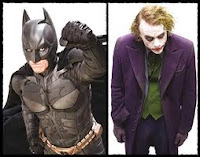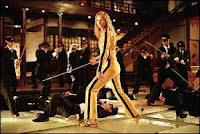2. How does your media product represent particular social groups?
Our thriller has a traditional approach to social particular social groups in the respect that we have cast the characters stereotypically.
Firstly gender- it is rare to see the female character as to behold the higher status or protagonist stature. This occurs particularly in thrillers where the antagonist is usually making the females feeling inferior and to become the victims where the protagonist is then there to ‘save the females’. We included this reference into our film in order to approach the thriller genre typically in order to convey a truthful response in relation to the theme. We have the two females who are at risk of kidnap from the male as he holds the higher, threatening status. This occurs in other thriller films such as ‘Batman: the dark knight’ where the Joker is the villain of the film whereas Batman is the protagonist.
 |
| Protagonist and antagonist examples |
· Female current victim: has the lowest status throughout the film opening as her character is held captive by the male character’s intentions. She portrays this as she is helplessly carried ‘unconscious’ throughout numerous shots within the clip by the male antagonist.
· Female possible victim: this character holds the most mysterious qualities in the sense that enigma is created through the appearance of her character. Is she next to become a victim? What is her relation with the other two characters? This supports the idea of enigma being created in a typical thriller and also reinforces the actions of the male in the other scenes as she is happily continuing her life.
· Male antagonist: the traditional element to a thriller film. The male within our film holds the superior status as he beholds villain-like qualities as he takes one female for advantage. His murderous ways become apparent when the clip ends on him committing his crime.
 |
| Sorority Row screen grabs, related to the age of the characters |
 |
| The 'boss' in full view of costume and status |
Secondly age- although the age of our characters in ‘Payday’ aren’t specified, it follows a typical age range as in real thriller films. In teenage thriller films such as ‘Sorority Row’, the characters are usually young and naïve as it reinforces and emphasises the bad/evil elements of the storyline as they are so oblivious. Although our characters are at work (due to the indication from the costume choice) they are within their late 20’s which supports the idea they are oblivious to the dangers around them. However, the male antagonist is portrayed to be around the 30/40 year old mark as he is also the ‘boss’ within the film, relating to the title ‘Payday’. This again supports the fact that he has the higher status as he is higher in ranking at the ‘office’.
· Female current victim: she is wearing basic black and white office wear to indicate her status within her work place, and also the fact that she is younger than this antagonist. This again relates to her naivety in initially trusting the man in her employment and thus ending up in her current situation.
· Female possible victim: she appears quite air-headed and youthful in relation to the dark scenes in which her scenes cut to. As she continues her day naively it could relate to the idea that she trusts the man at work and therefore maybe is too young to experience people like him and other such circumstances.
· Male antagonist: like other thriller films, and other films in general, the male is the oldest of the cast. This gives him the chance to give his character more mature characteristics and the ability to carry the victim on his shoulder. Without being classed as sexist, this gives the females an indication to show their inferiority in relation to himself.
 |
| Uma Therman in 'Kill Bill' shows representation of status in relation to Bill as she goes through all that trouble to hunt him down- shows he's hard to capture, again showing his status. |
 |
| David Carradine in 'Kill Bill' showing superiority over other character's as he causes the most chaos without physically being part of it all, emphasises his higher status. |
Finally social class- although not much is given away within the opening about the background story and relationships with the characters, it is apparent that the male does hold the higher status. As well as being the ‘boss’, he is also typically portrayed through the idea that he is a male. These elements are relatable to thrillers such as ‘Kill Bill vol:1’ where the male holds superiority of the females (the bride and Bill). This is where the females may seem tough, but the males hold the higher status over-all.
 |
| Victim's helpless status in comparison to the male antagonist |
· Female current victim: has she has little action and movement within the clip, this shows she doesn’t have the free will to do as she please unlike the other two (the other female and the male antagonist). She beholds the lowest status, but this reinforces how the act and actions of the male has made her unable to do as she pleases.
 |
| Happily going to work, naively |
· Female possible victim: she seems to have confidence in our film as she happily gets ready for her day. This shows how she looks forward to her job at work but is therefore naïve to the actions of the ‘boss’. However, she acts as though she has the ability to stand up for herself in later scenes, which relates back to the idea that we have created enigma for the audience as it isn't shown within the film that she even gets involved with the murderer.
· Male antagonist: obliviously have the higher status as he has control over the narrative and the murders themselves. His effect on other people’s lives shows his superiority within the film.
 A newly released thriller film ‘Hunger Games’ has hyped up a large demographic already within the first few weeks of release. Although this film doesn’t have the same qualities as my film in terms of the fact it isn’t exactly ‘psychological’, but it targets the same demographic that mine is aimed at. Therefore, I asked the same 30 people about this film…
A newly released thriller film ‘Hunger Games’ has hyped up a large demographic already within the first few weeks of release. Although this film doesn’t have the same qualities as my film in terms of the fact it isn’t exactly ‘psychological’, but it targets the same demographic that mine is aimed at. Therefore, I asked the same 30 people about this film…































.jpg)
